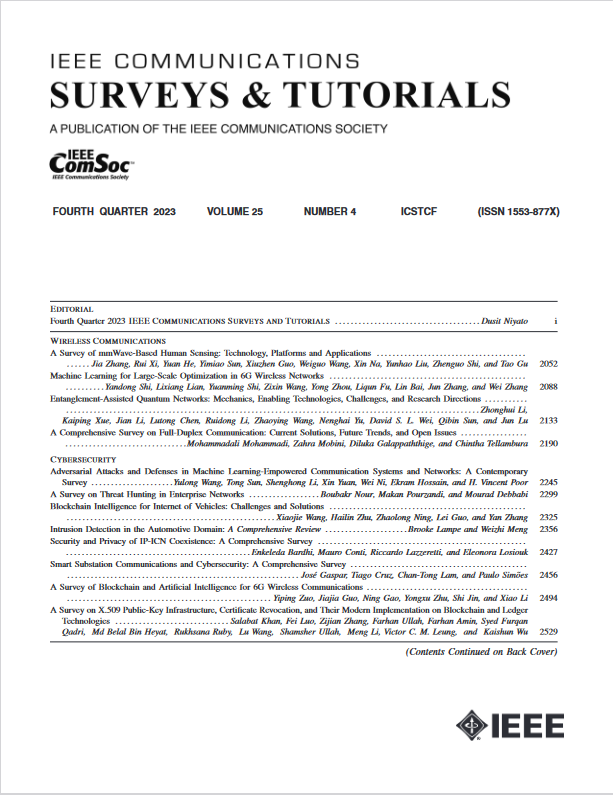Revolutionizing Future Connectivity: A Contemporary Survey on AI-Empowered Satellite-Based Non-Terrestrial Networks in 6G
IF 34.4
1区 计算机科学
Q1 COMPUTER SCIENCE, INFORMATION SYSTEMS
引用次数: 0
Abstract
Non-Terrestrial Networks (NTN) are expected to be a critical component of 6th Generation (6G) networks, providing ubiquitous, continuous, and scalable services. Satellites emerge as the primary enabler for NTN, leveraging their extensive coverage, stable orbits, scalability, and adherence to international regulations. However, satellite-based NTN presents unique challenges, including long propagation delay, high Doppler shift, frequent handovers, spectrum sharing complexities, and intricate beam and resource allocation, among others. The integration of NTNs into existing terrestrial networks in 6G introduces a range of novel challenges, including task offloading, network routing, network slicing, and many more. To tackle all these obstacles, this paper proposes Artificial Intelligence (AI) as a promising solution, harnessing its ability to capture intricate correlations among diverse network parameters. We begin by providing a comprehensive background on NTN and AI, highlighting the potential of AI techniques in addressing various NTN challenges. Next, we present an overview of existing works, emphasizing AI as an enabling tool for satellite-based NTN, and explore potential research directions. Furthermore, we discuss ongoing research efforts that aim to enable AI in satellite-based NTN through software-defined implementations, while also discussing the associated challenges. Finally, we conclude by providing insights and recommendations for enabling AI-driven satellite-based NTN in future 6G networks.革新未来连接:关于 6G 中人工智能驱动的卫星非地面网络的当代调查
非地面网络(NTN)有望成为第六代(6G)网络的重要组成部分,提供无处不在、连续和可扩展的服务。卫星利用其广泛的覆盖范围、稳定的轨道、可扩展性以及对国际法规的遵守,成为 NTN 的主要推动力。然而,基于卫星的 NTN 面临着独特的挑战,包括长传播延迟、高多普勒频移、频繁切换、频谱共享复杂性以及错综复杂的波束和资源分配等。在 6G 时代,将 NTN 集成到现有地面网络会带来一系列新的挑战,包括任务卸载、网络路由、网络切片等。为了解决所有这些障碍,本文提出人工智能(AI)作为一种有前途的解决方案,利用其捕捉各种网络参数之间错综复杂的相关性的能力。我们首先全面介绍了 NTN 和人工智能的背景,强调了人工智能技术在应对各种 NTN 挑战方面的潜力。接下来,我们概述了现有的工作,强调人工智能是基于卫星的 NTN 的有利工具,并探讨了潜在的研究方向。此外,我们还讨论了正在进行的研究工作,这些工作旨在通过软件定义的实现方式在基于卫星的 NTN 中启用人工智能,同时还讨论了相关的挑战。最后,我们就如何在未来的 6G 网络中实现人工智能驱动的星基 NTN 提出了见解和建议。
本文章由计算机程序翻译,如有差异,请以英文原文为准。
求助全文
约1分钟内获得全文
求助全文
来源期刊

IEEE Communications Surveys and Tutorials
COMPUTER SCIENCE, INFORMATION SYSTEMS-TELECOMMUNICATIONS
CiteScore
80.20
自引率
2.50%
发文量
84
审稿时长
6 months
期刊介绍:
IEEE Communications Surveys & Tutorials is an online journal published by the IEEE Communications Society for tutorials and surveys covering all aspects of the communications field. Telecommunications technology is progressing at a rapid pace, and the IEEE Communications Society is committed to providing researchers and other professionals the information and tools to stay abreast. IEEE Communications Surveys and Tutorials focuses on integrating and adding understanding to the existing literature on communications, putting results in context. Whether searching for in-depth information about a familiar area or an introduction into a new area, IEEE Communications Surveys & Tutorials aims to be the premier source of peer-reviewed, comprehensive tutorials and surveys, and pointers to further sources. IEEE Communications Surveys & Tutorials publishes only articles exclusively written for IEEE Communications Surveys & Tutorials and go through a rigorous review process before their publication in the quarterly issues.
A tutorial article in the IEEE Communications Surveys & Tutorials should be designed to help the reader to become familiar with and learn something specific about a chosen topic. In contrast, the term survey, as applied here, is defined to mean a survey of the literature. A survey article in IEEE Communications Surveys & Tutorials should provide a comprehensive review of developments in a selected area, covering its development from its inception to its current state and beyond, and illustrating its development through liberal citations from the literature. Both tutorials and surveys should be tutorial in nature and should be written in a style comprehensible to readers outside the specialty of the article.
 求助内容:
求助内容: 应助结果提醒方式:
应助结果提醒方式:


